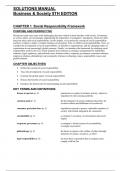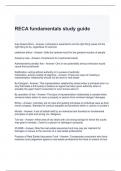SOLUTIONS MANUAL
Business & Society 8TH EDITION
CHAPTER 1 :Social Responsibility Framework
PURPOSE AND PERSPECTIVE
Businesses today must cope with challenging decisions related to their interface with society. Consumers,
as well as others, are increasingly emphasizing the importance of companies’ reputations, which are often
based on ethics and social responsibility. In this chapter, we examine the concept of social responsibility
and how it relates to today’s complex business environment. First, we define social responsibility. Next, we
consider the development of social responsibility, its benefits to organizations, and the changing nature of
expectations in our increasingly global economy. Finally, we introduce the framework for studying social
responsibility used by this text, which includes such elements as strategic management for stakeholder
relations; legal, regulatory, and political issues; business ethics; corporate governance; consumer relations;
employee relations; philanthropy and community relations; technology issues; sustainability issues; and
global relations.
CHAPTER OBJECTIVES
• Define the concept of social responsibility
• Trace the development of social responsibility
• Examine the global nature of social responsibility
• Discuss the benefits of social responsibility
• Introduce the framework for understanding social responsibility
KEY TERMS AND DEFINITIONS
license to operate (p. 4) permission to conduct a business activity, subject to
regulation by the licensing authority
common good (p. 5) the development of social conditions that allow for
societal welfare and fulfillment to be achieved
consumer protection laws (p. 5) regulations enacted to protect vulnerable members of
society with formal safeguards for consumers
sustainability (p. 5) a company’s economic, environmental, and social
impact
corporate governance (p. 6) a company’s formal system of accountability,
oversight, and control
philanthropy (p. 6) the desire to improve the welfare of others through
donations of money, resources, or effort
legal responsibility (p. 6) the most basic expectation that a company must
comply with the law
,employee well-being (p. 6) the health and wellness of employees,
including how workers feel about their work
and their working environment
social responsibility (p. 6) a strategic focus for fulfilling economic,
legal, ethical, and philanthropic
responsibilities, can also be referred to as
corporate social responsibility (CSR) when
adopted by a business
mission statement (p. 8) a summary of a company’s aims and values
vision statement (p. 8) a description of a company’s current and
future objectives to help align decisions with
their philosophy and goals
corporate culture (p. 8) shared values, attitudes, and beliefs that
characterize members of an organization
business ethics (p. 9) the principles, values, and norms that guide
individual and group behavior in the world of
business
principles (p. 9) specific and universal boundaries for
behavior that should never be violated
values (p. 10) enduring beliefs and ideals that are socially
enforced
norms (p. 10) standards of behavioral expectations that
guide, control, and regulate ethical conduct
code of ethics (p. 10) a written collection of the rules, principles,
values, and expectations of employee
behavior
philanthropic activities (p. 10) efforts made by a company to improve
human welfare and goodwill
stakeholder orientation (p. 11) the aim to benefit all parties affected by the
success or failure of an organization
resource-advantage theory (p. 11) a theory stating that the value of a resource is
viewed relative to its potential to create
competitive differentiation or customer value
stakeholders (p. 11) constituents who have an interest or stake in
a company’s products, industry, markets, and
outcomes
,interorganizational networks (p. 11) a set of organizations that are associated
through shared or mutual affiliations and
interests
core competencies (p. 13) unique advantages that differentiate a firm
from its competitors
environmental, social, and governance (ESG) (p. 16) a framework for evaluation of firm
performance in the areas of environmental,
social, and governance
, LECTURE OUTLINE
1) Introduction
a) Businesses today must cope with challenging decisions related to their interface with society.
b) Consumers and other stakeholders are increasingly emphasizing the importance of companies’
reputations, which are often based on ethics and social responsibility.
2) Social Responsibility Defined
a) In most societies, businesses are granted a license to operate and the right to exist through a
combination of social and legal institutions.
b) Businesses are expected to:
i) provide quality goods and services
ii) abide by laws and regulations
iii) treat employees fairly
iv) follow through on contracts
v) protect the natural environment
vi) meet warranty obligations
vii) adhere to many other standards of good business conduct
c) Companies that continuously meet and exceed these standards are often rewarded with:
i) customer satisfaction
ii) employee dedication
iii) investor loyalty
iv) strong relationships in the community
v) positive news and social media reports
vi) the time and energy to continue focusing on business-related concerns
d) Firms that fail to meet these responsibilities can face penalties, both formal and informal, and may
have their attention diverted from core business practice.
e) The goal is to prevent these negative outcomes in the future.
i) Whether the public attacks are physical or virtual, companies often spend significant resources
in explaining and defending their business decisions.
ii) A company engaged in alleged deceptive practices may face formal investigation by a
government agency and spend years defending itself.
f) Businesses today are expected to look beyond their self-interest and recognize that they belong to a
larger group, or society, that expects responsible participation.
i) If any group, society, or institution is to function, there must be a delicate interplay between
rights (i.e., what people expect to get) and responsibilities (i.e., what people are expected to
contribute) for the common good.
ii) Responsible conduct and policies yield significant benefits to society, as well as to shareholders
and other investors.





